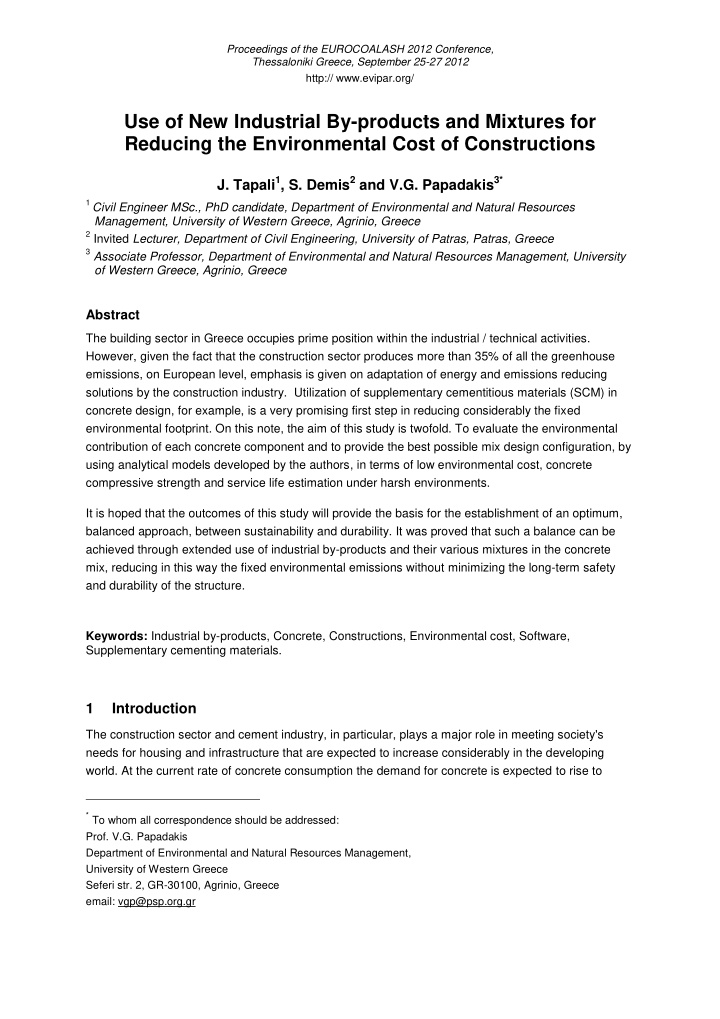



Proceedings of the EUROCOALASH 2012 Conference, Thessaloniki Greece, September 25-27 2012 http:// www.evipar.org/ Use of New Industrial By-products and Mixtures for Reducing the Environmental Cost of Constructions J. Tapali 1 , S. Demis 2 and V.G. Papadakis 3* 1 Civil Engineer MSc., PhD candidate, Department of Environmental and Natural Resources Management, University of Western Greece, Agrinio, Greece 2 Invited Lecturer, Department of Civil Engineering, University of Patras, Patras, Greece 3 Associate Professor, Department of Environmental and Natural Resources Management, University of Western Greece, Agrinio, Greece Abstract The building sector in Greece occupies prime position within the industrial / technical activities. However, given the fact that the construction sector produces more than 35% of all the greenhouse emissions, on European level, emphasis is given on adaptation of energy and emissions reducing solutions by the construction industry. Utilization of supplementary cementitious materials (SCM) in concrete design, for example, is a very promising first step in reducing considerably the fixed environmental footprint. On this note, the aim of this study is twofold. To evaluate the environmental contribution of each concrete component and to provide the best possible mix design configuration, by using analytical models developed by the authors, in terms of low environmental cost, concrete compressive strength and service life estimation under harsh environments. It is hoped that the outcomes of this study will provide the basis for the establishment of an optimum, balanced approach, between sustainability and durability. It was proved that such a balance can be achieved through extended use of industrial by-products and their various mixtures in the concrete mix, reducing in this way the fixed environmental emissions without minimizing the long-term safety and durability of the structure. Keywords: Industrial by-products, Concrete, Constructions, Environmental cost, Software, Supplementary cementing materials. 1 Introduction The construction sector and cement industry, in particular, plays a major role in meeting society's needs for housing and infrastructure that are expected to increase considerably in the developing world. At the current rate of concrete consumption the demand for concrete is expected to rise to * To whom all correspondence should be addressed: Prof. V.G. Papadakis Department of Environmental and Natural Resources Management, University of Western Greece Seferi str. 2, GR-30100, Agrinio, Greece email: vgp@psp.org.gr
about 16 billion tonnes a year by 2050 [1]. The challenge we face is to develop processes and practices that will curb the intensity of CO 2 emissions per ton of cement produced in order to strike a balance between climate change risk and global growth. From a production point of view almost every type of structural material used has a considerable impact on the local and global environment. In general, any set of construction materials entails certain aspects of environmental cost (in the form of carbon dioxide and other gasses emissions and energy consumed) from its manufacturing stage to its end-use (fixed environmental cost), or during- use of the structure (operational environmental cost) according to the particular type of construction. In concrete production for example [2], the main emissions to air are associated with the cement- making process, where during the stage of clinker formation, CO 2 gasses and other greenhouse emissions are emitted to the atmosphere (0.873 tonnes of CO 2 gases are emitted per 1 tonne of cement produced [3-4]. Cement manufacturing is a mature industry applying the same chemical process (in principle) for more than a hundred years (thus any revolutionary breakthroughs are rendered at a slow pace). Considering the facts that, the construction sector accounts for a considerable share of the total EU final energy consumption (more than 42%) and produces more than 35% of all the greenhouse emissions [4-5], with cement manufacturing contributing 5% of the global man made CO 2 emissions, increasing emphasis should be placed on investigating and enforcing ways and methodologies to make the construction industry in general a more environmental friendly sector. Given the availability of current raw materials in cement manufacturing, what is needed is to be able to achieve an optimum, balanced approach, between sustainability and durability when designing reinforced concrete structures. To achieve this, utilization of supplementary cementing by-products, like fly ash, rice husk ash (and others including ground granulated blast-furnace slag and silica fume) has been suggested as a solution (since they replace clinker to a great extend). Considerable amount of work on developing analytical models for the evaluation of SCM in concrete using the concept of efficiency factors (or k-values, to compare the relative performance of supplementary cementing materials on concrete durability) by Papadakis [6-8] and preliminary work undertaken by Papadakis et al. [9-11] on RHA has identified the high-added value of this materials and its pozzolanic properties on cement and mortar. Rice husk ash (RHA), an agricultural waste material, produced by controlled burning of rice husk have shown to contain reactive silica and alumina (in the form of metakaolin) which could contribute chemically to the Portland cement ingredients. In general, besides the effect they entail on early concrete strength and volume stability [12-13], they improve to a great extend the overall environmental contribution [13]. It has been calculated that 18 % replacement of Portland cement results in a 17 % reduction of the CO 2 emissions [4, 14]. It is believed that if just 30% of cement sed globally was replaced with supplementary cementing materials (SCM), the rise in CO 2 emissions from cement production could be reversed [4,14]. Under the scope of this study, an evaluation of these types of materials, as Type II additives on CEM I type of cement, and their effects in terms of their performance in carbonation and chloride exposure, for a service life of 50 years, in addition to their environmental output was presented. The overall aim is to portray the basis for the previously mentioned balanced approach between sustainability and durability of reinforced concrete structures (optimum solution).
Recommend
More recommend